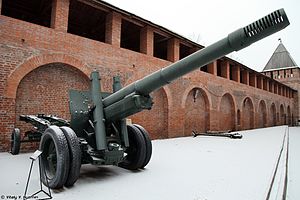This article includes a list of general references, but it lacks sufficient corresponding inline citations. (February 2012) |
| 152 mm howitzer-gun M1937 (ML-20) | |
|---|---|
 ML-20 in museum "The Smolensk Region in the years of Great Patriotic War", Smolensk. | |
| Type | Howitzer |
| Place of origin | Soviet Union |
| Service history | |
| Wars | Winter War World War II Six-Day War Yom Kippur War |
| Production history | |
| Designer | Design bureau of No. 172 Plant, headed by F. F. Petrov |
| Produced | 1937-1947 |
| No. built | 6,884 |
| Specifications | |
| Mass | combat: 7,270 kg (16,027 lb) travel: 7,930 kg (17,482 lb) |
| Length | 8.18 m (26 ft 10 in) (with limber; barrel pulled back) |
| Barrel length | bore: 4.24 m (13 ft 11 in) L/27.9 overall: 4.412 m (10 ft) L/29 (without muzzle brake) |
| Width | 2.35 m (7 ft 9 in) |
| Height | 2.27 m (7 ft 5 in) |
| Shell | 152 x 547 mm R |
| Caliber | 152.4 mm (6 in) |
| Breech | interrupted screw |
| Recoil | hydro-pneumatic |
| Carriage | split trail |
| Elevation | −2° to 65° |
| Traverse | 58° |
| Rate of fire | 3-4 rounds per minute |
| Muzzle velocity | 655 m/s (2,150 ft/s) |
| Maximum firing range | 17.23 km (10.7 mi) |
The 152 mm howitzer-gun M1937 (ML-20) (Russian: 152-мм гаубица-пушка обр. 1937 г. (МЛ-20)), is a Soviet heavy gun-howitzer. The gun was developed by the design bureau of the plant no 172, headed by F. F. Petrov, as a deep upgrade of the 152-mm gun M1910/34, in turn based on the 152-mm siege gun M1910, a pre-World War I design by Schneider. It was in production from 1937 to 1946. The ML-20 saw action in World War II, mainly as a corps / army level artillery piece of the Soviet Army. Captured guns were employed by Wehrmacht and the Finnish Army. Post World War II, the ML-20 saw combat in numerous conflicts during the mid to late twentieth century.